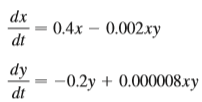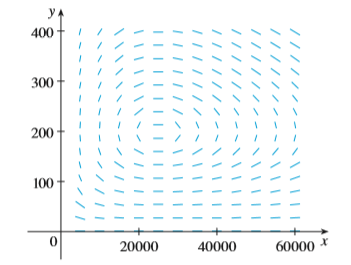Question: Populations of birds and insects are modeled
Populations of birds and insects are modeled by the equations 
(a) Which of the variables, x or y, represents the bird population and which represents the insect population? Explain. (b) Find the equilibrium solutions and explain their significance. (c) Find an expression for dy/dx. (d) The direction field for the differential equation in part (c) is shown. Use it to sketch the phase trajectory corresponding to initial populations of 100 birds and 40,000 insects. Then use the phase trajectory to describe how both populations change. (e) Use part (d) to make rough sketches of the bird and insect populations as functions of time. How are these graphs related to each other 
Transcribed Image Text:
dx 0.4x – 0.002.xy dt dy -0.2y + 0.000008xy dt yA 400 300 200 100 20000 40000 60000 * --- ////// 1- //// ///// //-- ///// //- ///
> Verify Formula 62 in the Table of Integrals.
> Recall that the normal line to a curve at a point P on the curve is the line that passes through P and is perpendicular to the tangent line at P. Find the curve that passes through the point (3, 2) and has the property that if the normal line is drawn at
> Use the graphs of x = f(t) and y = t(t) to sketch the parametric curve x = f(t), y = t(t). Indicate with arrows the direction in which the curve is traced as t increases.
> Verify Formula 33 in the Table of Integrals (a) by differentiation and (b) by using a trigonometric substitution.
> A curve called the folium of Descartes is defined by the parametric equations (a) Show that if (a, b) lies on the curve, then so does (b, a); that is, the curve is symmetric with respect to the line y = x. Where does the curve intersect this line? (b) F
> Evaluate the integral.
> Show that the angles between the polar axis and the asymptotes of the hyperbola / are given by /
> Find the values of x for which the series converges. Find the sum of the series for those values of x.
> Use the Table of Integrals on the Reference Pages to evaluate the integral.
> Show that if m is any real number, then there are exactly two lines of slope m that are tangent to the ellipse x2/a2 + y2/b2 = 1 and their equations are
> Use the method of cylindrical shells to find the volume generated by rotating the region bounded by the curves about the given axis. у —е", х — 0, у — 3;B about the х-ахis
> Find the curve that passes through the point (3, 2) and has the property that if the tangent line is drawn at any point P on the curve, then the part of the tangent line that lies in the first quadrant is bisected at P.
> Find an equation for the ellipse that shares a vertex and a focus with the parabola x2 + y = 100 and that has its other focus at the origin.
> Find an equation of the hyperbola with foci (0, ±4) and asymptotes y = ±3x.
> Use multiplication or division of power series to find the first three nonzero terms in the Maclaurin series for each function. y - e* In(1 + x)
> Find the Taylor polynomial T3(x) for the function f centered at the number a. Graph f and T3 on the same screen. f) — In x, а — 1
> Find an equation of the ellipse with foci (±4, 0) and vertices (±5, 0).
> Find the foci and vertices and sketch the graph. 25x? + 4y? + 50x – 16y = 59
> Evaluate the integral. dx X - 1
> Find the values of x for which the series converges. Find the sum of the series for those values of x. E (-5)"x"
> Find the foci and vertices and sketch the graph. 4x? - у? — 16 %3D
> Find the foci and vertices and sketch the graph. x2 y? 1 8 9
> Determine whether the sequence converges or diverges. If it converges, find the limit. (-3)" an n!
> The curves defined by the parametric equations are called strophoids (from a Greek word meaning “to turn or twist”). Investigate how these curves vary as c varies. (? — с) y = 1? + 1 1? - c 1? + 1
> Use the method of cylindrical shells to find the volume generated by rotating the region bounded by the curves about the given axis. у —е", у— 0, х — —1, х — 0; about x— 1 %3D
> Find the area of the surface obtained by rotating the given curve about the x-axis. x = 2 + 3t, y = cosh 31, 0<i<1
> Find the area of the surface obtained by rotating the given curve about the x-axis. x = 4 T, y=+, x = 4 /t, y=- 3 212"
> Find the length of the curve. r= sin'(0/3), 0< 0<
> Sketch the parametric curve and eliminate the parameter to find the Cartesian equation of the curve. x = 2 cos 0, y =1 + sin0 = 1 + sin@
> Use multiplication or division of power series to find the first three nonzero terms in the Maclaurin series for each function. y SI sin x
> Express the number as a ratio of integers. 5.71358
> Evaluate the integral.
> Determine whether the series is convergent or divergent. If it is convergent, find its sum. 1 Σ 1 + (?)"
> Calculate, to four decimal places, the first ten terms of the sequence and use them to plot the graph of the sequence by hand. Does the sequence appear to have a limit? If so, calculate it. If not, explain why. 10" a, = 1 + 9"
> Find the length of the curve. r= 1/0, 7< 0 < 27
> Find the length of the curve. x = 2 + 3t, y = cosh 31, 0< t<1
> Find the length of the curve. x = 312, y = 21°, 0<t<2
> Find the area of the region that lies inside both of the circles /
> Use the method of cylindrical shells to find the volume generated by rotating the region bounded by the curves about the given axis. у —е", у—е", х — 1;B about the y-аxis
> At what points does the curve have vertical or horizontal tangents? Use this information to help sketch the curve. X= 2a cos t - a cos 21 y = 2a sin t – a sin 2t
> Find the area enclosed by the loop of the curve in Exercise 27. Data from Exercise 27: Use a graph to estimate the coordinates of the lowest point on the curve x = t3 - 3t, y = t2 + t + 1. Then use calculus to find the exact coordinates.
> Determine whether the geometric series is convergent or divergent. If it is convergent, find its sum. 3 – 4 + – 4 - +
> Determine whether the sequence converges or diverges. If it converges, find the limit. a„ = In(n + 1) – In n
> Use a graph to estimate the coordinates of the lowest point on the curve x = t3 - 3t, y = t2 + t + 1. Then use calculus to find the exact coordinates.
> Find the volume obtained by rotating the region bounded by the curves about the given axis. у — sin x, у — 0, п/2 <x< п; about the x-axis
> Find dy/dx and d2y/dx2. x = 1 + t2, y = t – t3
> Use multiplication or division of power series to find the first three nonzero terms in the Maclaurin series for each function. y - sec x
> Find dy/dx and d2y/dx2. x = t + sint. y = t – cos t
> Find the slope of the tangent line to the given curve at the point corresponding to the specified value of the parameter. r = e e "; 0 = T
> Find the slope of the tangent line to the given curve at the point corresponding to the specified value of the parameter. x = In 1, y = 1 + t²; t=1
> Use the method of cylindrical shells to find the volume generated by rotating the region bounded by the curves about the given axis. y = cos(Tx/2), y= 0, 0<x< 1; about the y-axis
> Determine whether the sequence converges or diverges. If it converges, find the limit. {{东春 !!!!!!! ..} 3> 4> 6
> Express the number as a ratio of integers. 1.234567
> A tank contains 100 L of pure water. Brine that contains 0.1 kg of salt per liter enters the tank at a rate of 10 L/min. The solution is kept thoroughly mixed and drains from the tank at the same rate. How much salt is in the tank after 6 minutes?
> Determine whether the sequence converges or diverges. If it converges, find the limit. (2n – 1)! (2n + 1)!
> The von Bertalanffy growth model is used to predict the length L(t) of a fish over a period of time. If L is the largest length for a species, then the hypothesis is that the rate of growth in length is proportional to L` 2 L, the length yet to be achiev
> Use multiplication or division of power series to find the first three nonzero terms in the Maclaurin series for each function. y = e * cos x
> Determine whether the sequence converges or diverges. If it converges, find the limit. {0, 1, 0, 0, 1, 0, 0, 0, 1, . }
> Express the number as a ratio of integers. 10.135 = 10.135353535 ...
> Use a graph to find approximate x coordinates of the points of intersection of the given curves. Then find (approximately) the area of the region bounded by the curves. y = x у — х Iп(x + 1), у3 Зх — .2
> Evaluate the integral. ( In Va dx
> Solve the initial-value problem. dr + 2tr = r, r(0) = 5 dt
> Determine whether the series converges or diverges. 1/m Σ 1 п
> Solve the differential equation. x?y' – y = 2x'e-1/½
> Solve the differential equation. 2ye "'y' = 2x + 3 /x %3D
> Solve the differential equation. dx 1 - t + x - tx dt
> Determine whether the sequence converges or diverges. If it converges, find the limit. а, — п — уп +1 ул + 3
> Use the Table of Integrals on the Reference Pages to evaluate the integral. cot x - dx 1 + 2 sin x
> Use the Table of Integrals on the Reference Pages to evaluate the integral. cos x /4 + sin²x dx
> Express the number as a ratio of integers. 2.516 = 2.516516516 ...
> Use the Table of Integrals on the Reference Pages to evaluate the integral. | csc't dt
> Use the series in Example 13(b) to evaluate We found this limit in Example 4.4.4 using l’ Hospital’s Rule three times. Which method do you prefer? tan x - x lim
> Graph the function f(x) = cos2x sin3x and use the graph to guess the value of the integral / . Then evaluate the integral to confirm your guess.
> Use a graph to find approximate x­ coordinates of the points of intersection of the given curves. Then find (approximately) the area of the region bounded by the curves. y = arcsin n(4x), у — 2 — х?
> Evaluate the indefinite integral. Illustrate and check that your answer is reasonable by graphing both the function and its antiderivative (take C = 0). dx /x² + 1
> Determine whether the sequence converges or diverges. If it converges, find the limit. an arctan(In n)
> Evaluate the indefinite integral. Illustrate and check that your answer is reasonable by graphing both the function and its antiderivative (take C = 0). In(x² + 2x + 2) dx
> Evaluate the integral or show that it is divergent. tan 'x - dx x?
> Solve the differential equation. sin x y' = xe y cos x
> Test the series for convergence or divergence. E n’e E n²e n-
> Evaluate the integral or show that it is divergent. dx 4x2 + 4x + 5
> Evaluate the integral or show that it is divergent. dx x? 2x
> Evaluate the integral or show that it is divergent. - : dx
> Evaluate the integral or show that it is divergent. ах 2 - Зх · dx
> Use series to evaluate the limit. x3 – 3x + 3 tan 'x lim
> Evaluate the integral or show that it is divergent. In x
> Determine whether the series is convergent or divergent. If it is convergent, find its sum. 2" + 4" Σ e"
> Find a polar equation for the curve represented by the given Cartesian equation. x? – y? = 4
> Find the area of the region bounded by the given curves. y - x'e *, y- xe * хе
> Evaluate the integral or show that it is divergent. y dy - 2 /y – 2
> Evaluate the integral or show that it is divergent. dx ½ x In x
> A sequence of terms is defined by aj = 1 а, — (5 — п)а, I Calculate Σa.
> Evaluate the integral or show that it is divergent. In x dx a.
> Evaluate the integral or show that it is divergent. 1 · dx. (2x + 1)'
> Evaluate the integral. Ls Vtan o Ju/4 sin 20 *w OP
> (a) Use Euler’s method with step size 0.2 to estimate y(0.4), where y(x) is the solution of the initial-value problem (b) Repeat part (a) with step size 0.1. (c) Find the exact solution of the differential equation and compare the value
> Evaluate the integral. 2x xe 1/2 dx Jo (1 + 2x)²
> Determine whether the sequence converges or diverges. If it converges, find the limit. an Vn
> Evaluate the integral. ·dx
> Evaluate the integral. (cos x + sin x)? cos 2x dx

